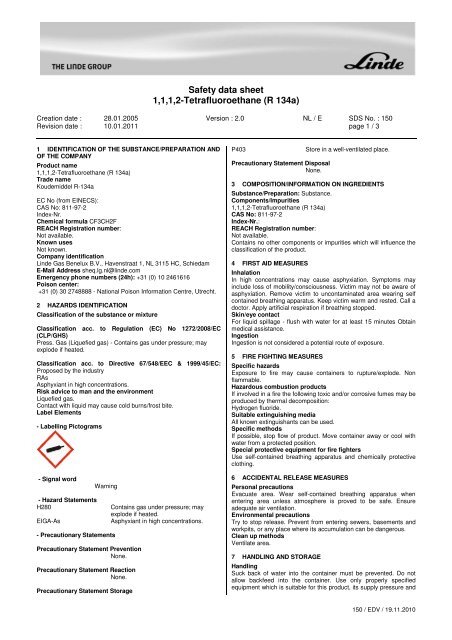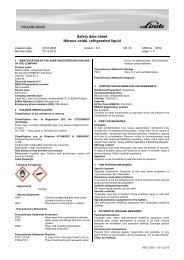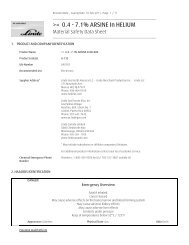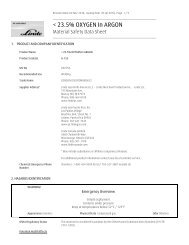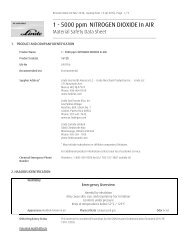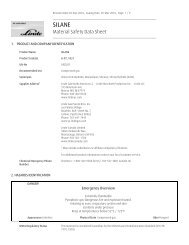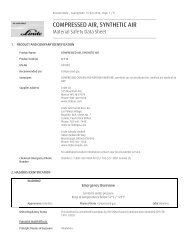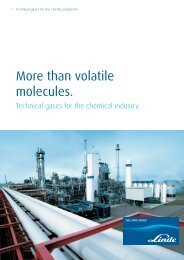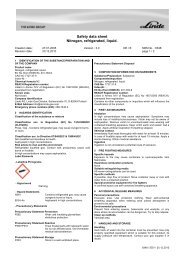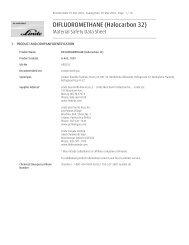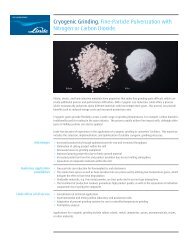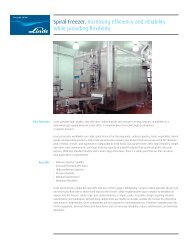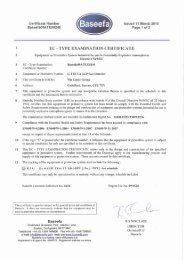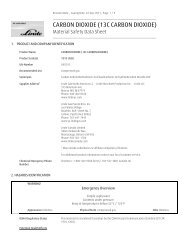Refrigerant R134a - Linde Gas
Refrigerant R134a - Linde Gas
Refrigerant R134a - Linde Gas
You also want an ePaper? Increase the reach of your titles
YUMPU automatically turns print PDFs into web optimized ePapers that Google loves.
Safety data sheet1,1,1,2-Tetrafluoroethane (R 134a)Creation date : 28.01.2005 Version : 2.0 NL / E SDS No. : 150Revision date : 10.01.2011 page 1 / 31 IDENTIFICATION OF THE SUBSTANCE/PREPARATION ANDOF THE COMPANYProduct name1,1,1,2-Tetrafluoroethane (R 134a)Trade nameKoudemiddel R-134aEC No (from EINECS):CAS No: 811-97-2Index-Nr.Chemical formula CF3CH2FREACH Registration number:Not available.Known usesNot known.Company identification<strong>Linde</strong> <strong>Gas</strong> Benelux B.V., Havenstraat 1, NL 3115 HC, SchiedamE-Mail Address sheq.lg.nl@linde.comEmergency phone numbers (24h): +31 (0) 10 2461616Poison center:+31 (0) 30 2748888 - National Poison Information Centre, Utrecht.2 HAZARDS IDENTIFICATIONClassification of the substance or mixtureClassification acc. to Regulation (EC) No 1272/2008/EC(CLP/GHS)Press. <strong>Gas</strong> (Liquefied gas) - Contains gas under pressure; mayexplode if heated.Classification acc. to Directive 67/548/EEC & 1999/45/EC:Proposed by the industryRAsAsphyxiant in high concentrations.Risk advice to man and the environmentLiquefied gas.Contact with liquid may cause cold burns/frost bite.Label Elements- Labelling Pictograms- Signal word- Hazard StatementsH280EIGA-AsWarning- Precautionary StatementsPrecautionary Statement PreventionNone.Precautionary Statement ReactionNone.Precautionary Statement StorageContains gas under pressure; mayexplode if heated.Asphyxiant in high concentrations.P403Precautionary Statement DisposalNone.Store in a well-ventilated place.3 COMPOSITION/INFORMATION ON INGREDIENTSSubstance/Preparation: Substance.Components/Impurities1,1,1,2-Tetrafluoroethane (R 134a)CAS No: 811-97-2Index-Nr.:REACH Registration number:Not available.Contains no other components or impurities which will influence theclassification of the product.4 FIRST AID MEASURESInhalationIn high concentrations may cause asphyxiation. Symptoms mayinclude loss of mobility/consciousness. Victim may not be aware ofasphyxiation. Remove victim to uncontaminated area wearing selfcontained breathing apparatus. Keep victim warm and rested. Call adoctor. Apply artificial respiration if breathing stopped.Skin/eye contactFor liquid spillage - flush with water for at least 15 minutes Obtainmedical assistance.IngestionIngestion is not considered a potential route of exposure.5 FIRE FIGHTING MEASURESSpecific hazardsExposure to fire may cause containers to rupture/explode. Nonflammable.Hazardous combustion productsIf involved in a fire the following toxic and/or corrosive fumes may beproduced by thermal decomposition:Hydrogen fluoride.Suitable extinguishing mediaAll known extinguishants can be used.Specific methodsIf possible, stop flow of product. Move container away or cool withwater from a protected position.Special protective equipment for fire fightersUse self-contained breathing apparatus and chemically protectiveclothing.6 ACCIDENTAL RELEASE MEASURESPersonal precautionsEvacuate area. Wear self-contained breathing apparatus whenentering area unless atmosphere is proved to be safe. Ensureadequate air ventilation.Environmental precautionsTry to stop release. Prevent from entering sewers, basements andworkpits, or any place where its accumulation can be dangerous.Clean up methodsVentilate area.7 HANDLING AND STORAGEHandlingSuck back of water into the container must be prevented. Do notallow backfeed into the container. Use only properly specifiedequipment which is suitable for this product, its supply pressure and150 / EDV / 19.11.2010
Safety data sheet1,1,1,2-Tetrafluoroethane (R 134a)Creation date : 28.01.2005 Version : 2.0 NL / E SDS No. : 150Revision date : 10.01.2011 page 2 / 3temperature. Contact your gas supplier if in doubt. Refer tosupplier's handling instructions.StorageSecure cylinders to prevent them falling. Keep container below 50°Cin a well ventilated place.8 EXPOSURE CONTROLS/PERSONAL PROTECTIONExposure limit valueValue type value NotePublic limit value TGG-8h (NL)1.000 ppmPersonal protectionEnsure adequate ventilation. Do not smoke while handling product.Carry working gloves and protection shoes while handling gascylinders.9 PHYSICAL AND CHEMICAL PROPERTIESGeneral informationAppearance/Colour: Colourless gas.Odour: EtherealImportant information on environment, health and safetyMolecular weight: 102 g/molMelting point: -101 °CBoiling point: -26 °CCritical temperature: 100,6 °CFlammability range: Non flammable.Relative density, gas: Heavier than air.Vapour Pressure 20 °C: 5,7 barSolubility mg/l water: 1930 mg/lOther data<strong>Gas</strong>/vapour heavier than air. May accumulate in confined spaces,particularly at or below ground level.10 STABILITY AND REACTIVITYStability and reactivityMay react violently with alkaline-earth and alkali metals.11 TOXICOLOGICAL INFORMATIONAcute toxicityNo known toxicological effects from this product.12 ECOLOGICAL INFORMATIONGeneralNo known ecological damage caused by this product.13 DISPOSAL CONSIDERATIONSGeneralDo not discharge into any place where its accumulation could bedangerous. Contact supplier if guidance is required.EWC Nr. 16 05 0514 TRANSPORT INFORMATIONADR/RIDClass 2 Classification Code 2AUN number and proper shipping nameUN 3159 1,1,1,2-TetrafluoroethaneUN 3159 1,1,1,2-TetrafluoroethaneLabels 2.2 Hazard number 20IMDGClass 2.2UN number and proper shipping nameUN 3159 1,1,1,2-TetrafluoroethaneLabels 2.2Packing Instruction P200EmSFC,SVIATAClass 2.2UN number and proper shipping nameUN 3159 1,1,1,2-TetrafluoroethaneLabels 2.2Packing Instruction P200Other transport informationAvoid transport on vehicles where the load space is not separatedfrom the driver's compartment. Ensure vehicle driver is aware of thepotential hazards of the load and knows what to do in the event ofan accident or an emergency. Before transporting productcontainers ensure that they are firmly secured. Ensure that thecylinder valve is closed and not leaking. Ensure that the valve outletcap nut or plug (where provided) is correctly fitted. Ensure that thevalve protection device (where provided) is correctly fitted. Ensureadequate ventilation. Ensure compliance with applicable regulations.15 REGULATORY INFORMATIONFurther national regulations- Publication series of Dangerous Goods: PGS 15 - Storage ofpacked dangerous goods (published by the Ministry of Housing,Spatial Planning and Environment (VROM)).- Working conditions Catalogue AI-18 (Laboratory) and AI-31(Dangerous Substances) (published by SDU Publishing business).- Ministry for Social Affairs and Employment: Regulation 4.6-1 -Prevention of accidents on the account of storage, use and transportof pressure receptacles.This substance or preparation above certain volume may have to beincluded in a SEVESO II submission or any other applicable nationalregulation.16 OTHER INFORMATIONEnsure all national/local regulations are observed. The hazard ofasphyxiation is often overlooked and must be stressed duringoperator training. Before using this product in any new process orexperiment, a thorough material compatibility and safety studyshould be carried out.AdviceWhilst proper care has been taken in the preparation of thisdocument, no liability for injury or damage resulting from its use canbe accepted. Details given in this document are believed to becorrect at the time of going to press.Further informationKühn-Birett: Merkblätter gefährliche ArbeitsstoffeHommel: Handbook of dangerous goods<strong>Linde</strong> safety adviceNo. 3 Oxygen deficiencyNo. 7 Safe handling of gas cylinders and cylinder bundlesEnd of document150 / EDV / 19.11.2010
Safety data sheet1,1,1,2-Tetrafluoroethane (R 134a)Creation date : 28.01.2005 Version : 2.0 NL / E SDS No. : 150Revision date : 10.01.2011 page 3 / 3150 / EDV / 19.11.2010


